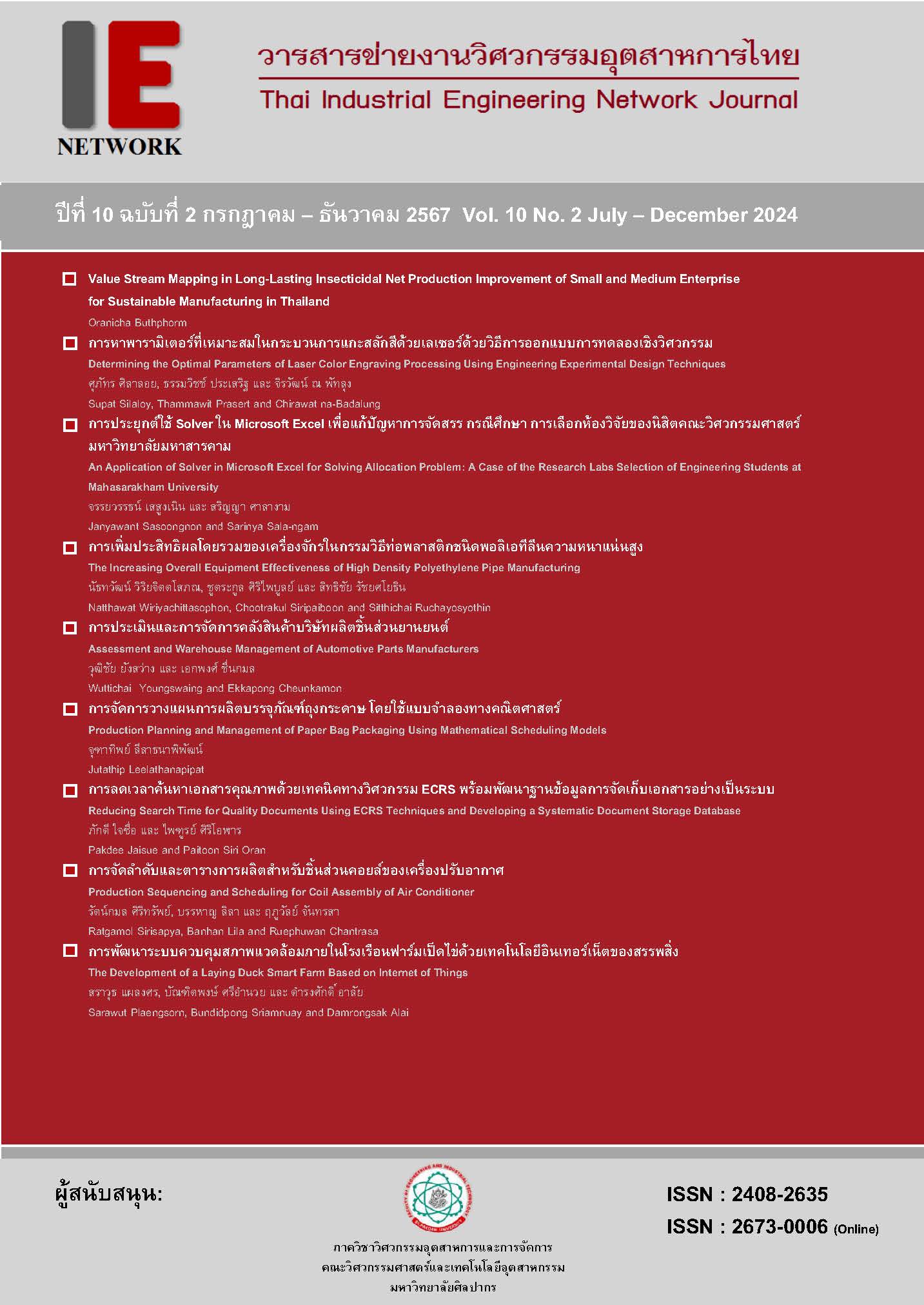Assessment and Warehouse Management of Automotive Parts Manufacturers
Main Article Content
Abstract
The objective of this research is to improve and reduce the time in the storage and picking process according to the product sheet and to evaluate the efficiency of warehouse management before and after the improvement of the warehouse of the automotive parts manufacturing company by analyzing the warehouse problem using the fishbone diagram, ABC analysis, and the evaluation of warehouse management efficiency (Industrial logistics performance index: ILPI) to propose an efficient and cost-effective operation approach. The initial research study and analysis of the current condition of the warehouse, adjusting the product placement, and trying to collect the picking time of the original placement to compare with the newly made placement by rearranging the placement to make the work faster result in lower costs. By randomly selecting the product sheet to experiment with the picking method and collecting time data to compare and find the best time, it was found that the picking time could be reduced by 366 seconds or 49.51 percent, and the average storage time of finished goods was reduced by 10 days. The inventory accuracy rate increased by 99.2 percent, making the warehouse management system and product picking more efficient.
Article Details

This work is licensed under a Creative Commons Attribution-NonCommercial-NoDerivatives 4.0 International License.
บทความ ข้อมูล เนื้อหา รูปภาพ ฯลฯ ที่ได้รับการตีพิมพ์ในวารสารฯ ถือเป็นลิขสิทธิ์ของวารสารฯ หากบุคคลหรือหน่วยงานใดต้องการนำทั้งหมดหรือส่วนหนึ่งส่วนใดไปเผยแพร่ต่อหรือเพื่อกระทำการใดๆ จะได้รับอนุญาต แต่ห้ามนำไปใช้เพื่่อประโยชน์ทางธุรกิจ และห้ามดัดแปลง
References
Rebeloa C. G. S., Pereiraa M. T., Silva F. J. G., Ferreira L. P., and Sá J. C. 2021, The relevance of space analysis in warehouse management. Procedia Manufacturing, p. 471-478.
Antonio Cosma, Romina Contea, Vittorio Solina ,and Giuseppina Ambrogio, Design of KPIs for evaluating the environmental impact of warehouse operations: a case study. Procedia Computer Science, 2024. 232: p. 2701-2708.
Phupattarakit, T. and P. Chutima. Warehouse Management Improvement for a Textile Manufacturer. In IEEE 6th International Conference on Industrial Engineering and Applications (ICIEA). 2019.
ธงชัย แสงสุวรรณดี และ สกนธ์ คล่องบุญจิต, “การเพิ่มประสิทธิภาพการจัดการคลังสินค้า ด้วยเทคนิค ABC และ การพยากรณ์ กรณีศึกษาระบบการจัดเก็บสินค้า”. วิศวสารลาดกระบัง, ปี ที่ 38 ฉบับที่ 4 ธันวาคม, 2564.
รัตนา ธัญญเจริญ, ฉัตรชัย เหล่าเขตการณ์และ เชษฐ์ภณัฏ ปัญญวัชรวงศ์, “แนวทางการปรับปรุงระบบการจัดการคลังสินค้าสาเร็จรูปด้วยวิธี ABC Analysis กรณีศึกษา บริษัทจำหน่ายอุปกรณ์อิเล็กทรอนิกส์ในจังหวัดสมุทรสาคร”. วารสารมนาย์ศาสตร์และสังคมศาสตร์ มหาวิทยาลัยธนบุรี.ฉบับที่ 1 เดือนมกราคม-เมษายน,2563.
Burganova, N., Grznar, P., Gregor, M., & Mozol, Š.,2021. Optimalisation of internal logistics transport time through warehouse management: case study. Transportation Research Procedia, 55, 553-560.
Van den Berg, J. P., & Zijm, W. H.,1999. Models for warehouse management: Classification and examples. International journal of production economics, 59(1-3), 519-528.
Sakdiyah, S. H., Eltivia, N., & Afandi, A,2022. Root cause analysis using fishbone diagram: company management decision making. Journal of Applied Business, Taxation and Economics Research, 1(6), 566-576.
Zhang, Z., Li, K. W., Guo, X., & Huang, J. ,2020. A probability approach to multiple criteria ABC analysis with misclassification tolerance. International journal of production economics, 229, 107858.
กองโลจิสติกส์ กรมส่งเสริมอุตสาหกรรม. คู่มือการประเมินประสิทธิภาพและศักยภาพการจัดการโลจิสติกส์์และซัพพลายเชน.,2567.


